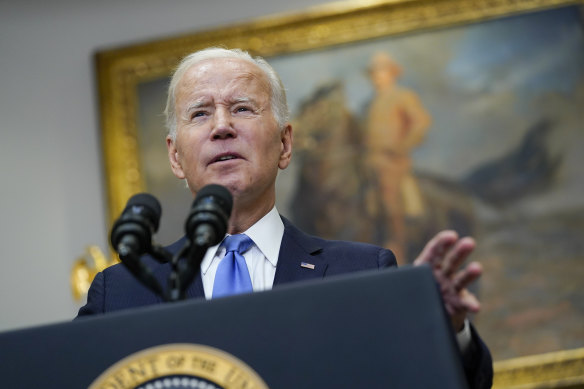This is a critical week for Russia’s cash machine
Now, with China’s economy almost flatlining as a result of its COVID-related lockdowns and India’s near-satiated sales volumes to those markets are falling away even as prices have fall back below $US90 a barrel. The obvious way to compensate for reduced volumes is to reinflate prices by curtailing supply.
That objective is becoming more urgent because of the looming multi-tiered sanctions on Russian oil.

An end to the volatility in the oil market does not look in sight. Credit:AP
From December, previously-agreed EU and US measures that would deny insurance and finance to those transporting Russia oil, backed by the threat of financial sanctions, will be imposed.
With much of Russia’s oil shipped by third parties, that could have a chilling impact on Russia’s oil revenues, despite Russia’s efforts to create its own shipping insurance and funding vehicles.
It could also, however, have a dramatic impact on oil prices if the source of about 10 per cent of the world’s oil supply was choked.
Loading
The price could easily soar way past the $US100 a barrel level given that the other OPEC members are already struggling to meet their production targets and therefore probably couldn’t fill in the shortfall in supply create by heavily-reduced Russian volumes.
That’s where the US concept of a price cap on Russia oil that the EU hopes to approve this week comes in.
The idea is that the US and EU would set a price for Russia’s oil at a small margin above its cost of production, backed by the threat of sanctions on anyone paying a higher price. That would leave an incentive for Russia to keep producing and selling its oil even though it would receive substantially less revenue.
While it is unlikely that China, India, Turkey or smaller buyers in Asia would formally observe the price cap, the US expectation is that they would use that as leverage to drive even harder bargains with Russia and therefore contribute, in their own self-interest, to the West’s cause.
Russia has threatened to respond by ceasing to produce but the losses of revenue wouldn’t make that a viable longer-term strategy. Oil and gas revenues contributed about half Russia’s budget revenues last year and would be a significantly higher percentage this year given the effect of the financial and trade sanctions on the rest of its economy and the vastly-reduced revenue from sales of gas to Europe.

The Biden administration has been steadily depleting US oil reserves, adding another piece to the oil puzzle.Credit:AP
The Saudis’ motives for supporting the OPEC+ production cuts aren’t clear.
They do have a long-standing relationship with the US but Russia is also a key associate of the core cartel and vital to maintaining its influence over the oil market.
Agreeing to cuts at the upper end of the proposed range might help keep Russia onside with OPEC but it would also allow some scope for the Saudis to bring back production if the sanctions and price caps on Russia’s oil prove too disruptive.
The EU’s imposition of price caps isn’t guaranteed, with Austria and Hungary (as usual) voicing objections. Greece, Cyprus and Malta, whose tanker fleets carry most of Russia’s oil, also aren’t completely on board and are pushing for some exemptions. Sanctions decision by the EU require unanimous support from the 27 member countries.
Even if the EU can gain that approval the level of the cap would need to be determined by the G7 group of advanced economies – the US, UK, Canada, Germany, France, Italy and Japan.
If the oil market has been volatile through this year so far, the confluence of the OPEC+ and EU decisions and the imminent end of the deployment of America’s strategic reserves almost ensures that the outlook will be even more uncertain and volatile.
Adding to the uncertainty about what the state of the oil market would look like if OPEC+ does cut production significantly and Russia’s output is affected by the proposed sanctions and price caps is a nearing of the end of the Biden administration’s decision to effect the largest-ever sell down of America’s strategic petroleum reserve.
Since March, in an effort to dampen the impact of the elevated oil prices on US gasoline prices, the US has released nearly 170 million barrels from that reserve, which now contains its lowest inventories for 40 years.
The plan was to release one million barrels a day for six months, which means the releases were scheduled to end this month. The administration, however, has extended them for at least another month.
Loading
At some point those reserves will need to be replenished, adding a new source of demand to the market, although that buying could be spread over years.
In any event, when the program does end another million barrels a day of supply will be withdrawn from the market, exaggerating the impact of whatever OPEC+ does and whatever the effect of the sanctions and price caps on Russia oil might be.
If the oil market has been volatile through this year so far, the confluence of the OPEC+ and EU decisions and the imminent end of the deployment of America’s strategic reserves almost ensures that the outlook will be even more uncertain and volatile.
The Business Briefing newsletter delivers major stories, exclusive coverage and expert opinion. Sign up to get it every weekday morning.
For all the latest Business News Click Here
For the latest news and updates, follow us on Google News.
